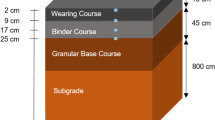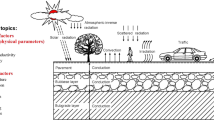Abstract
Permeable pavements help reduce surface temperatures and have been widely implemented in urban areas. This study utilized an in-use permeable pavement sidewalk in front of a mass rapid transit station in the Taipei city center of Taiwan to determine the actual pavement surface temperature performance. A neighboring asphalt road and impervious pavement were also monitored. With a full year of continuous monitoring, the results showed that the temperature of permeable pavement was 3.7 °C lower than that of impervious pavement and 4.5 °C lower than that of asphalt pavement in the hot season. The frequent rainfall in spring resulted in the smallest temperature differences between the different pavement types. The cooling effects of permeable pavement differed at the different air temperatures. At air temperatures lower than 15 °C, the differences among pavement surface temperatures were noticeable. However, when the air temperature was higher than 35 °C, the surface temperature of permeable pavement was not different from that of impervious pavement and was greater than 55 °C. Field observations were carried out to determine the effects on the apparent temperature and the future surface temperature of climate change scenarios. The results showed that permeable pavement could reduce the average apparent temperature to near the air temperature, and asphalt pavement could increase the apparent temperature by 1.2 °C, assuming that the pavement temperature completely affects the air temperature. With the good prediction ability of the machine learning approach and 15 environmental factors, the preliminary prediction showed the projected surface temperature change in Taipei city in 2033. In the worst-case scenario, the average impervious pavement temperature is as high as 39.12 °C, whereas the average permeable pavement temperature is 32.50 °C.










Similar content being viewed by others
Data availability
All the data and materials used in this paper are available from the corresponding author. The field pavement temperatures and weather data were measured by the authors. The future climate change data are obtained from the public official database (TCCIP).
References
Almeida, S. P., Casimiro, E., & Calheiros, J. (2010). Effects of apparent temperature on daily mortality in Lisbon and Oporto Portugal. Environmental Health, 9, 12. https://doi.org/10.1186/1476-069X-9-12
Almendra, R., Loureiro, A., Silva, G., Vasconcelos, J., & Santana, P. (2019). Short-term impacts of air temperature on hospitalizations for mental disorders in Lisbon. Science of the Total Environment, 647, 127–133.
Ayasrah, U. B., Tashman, L., Alomari, A., & Asi, I. (2023). Development of a temperature prediction model for flexible pavement structures. Case Study in Construction Materials, 18, e01697.
Breiman, L. (2001). Random forests. Machine Learning, 45, 5–32. https://doi.org/10.1023/A:1010933404324
Cao, R., Wang, Y., Huang, J., He, J., Ponsawansong, P., Jin, J., Xu, Z., Yang, T., Pan, X., Prapamontol, T., & Li, G. (2021). The mortality effect of apparent temperature: A multi-city study in Asia. International Journal of Environmental Research and Public Health, 18, 4675.
Chen, J., Wang, & Xie, P. (2019). Pavement temperature prediction: Theoretical models and critical affecting factors. Applied Thermal Engineering, 158, 113755.
Gartland, L. M. (2012). Heat islands: Understanding and mitigating heat in urban areas. Routledge.
Golden, J. S., & Kaloush, K. E. (2006). Mesoscale and microscale evaluation of surface pavement impacts on the urban heat island effects. International Journal of Pavement Engineering, 7(1), 37–52.
Guan, K. K. (2011). Surface and ambient air temperatures associated with different ground material: A case study at the University of California, Berkeley. Environmental Science, 196, 1–14.
Gui, J., Phelan, P. E., Kaloush, K. E., & Golden, J. S. (2007). Impact of pavement thermophysical properties on surface temperatures. Journal of Materials in Civil Engineering, 19(8), 683–690.
Hendel, M., Parison, S., Grados, A., & Royon, L. (2018). Which pavement structures are best suited to limiting the UHI effect? A laboratory-scale study of Parisian pavement structures. Building Environment, 144, 216–229.
Hermansson, Å. (2000). Simulation model for calculating pavement temperatures including maximum temperature. Transportation Research Record, 1699(1), 134–141.
Ho, H. C., Knudby, A., Xu, Y., Hodul, M., & Aminipouri, M. (2016). A comparison of urban heat islands mapped using skin temperature, air temperature, and apparent temperature (Humidex), for the greater Vancouver area. Science of the Total Environment, 544, 929–938.
Huang, J., Li, A., & Song, Z. (2022). Historical global land surface air apparent temperature and its future changes based on CMIP6 projections. Science of the Total Environment, 816, 151656.
IPCC, (2021). Climate change 2021: The physical science basis.
Iverson, L. R., Prasad, A. M., Matthews, S. N., & Peters, M. (2008). Estimating potential habitat for 134 eastern US tree species under six climate scenarios. Forest Ecology and Management, 254, 390–406.
Jato-Espino, D., Manchado, C., Roldan-Valcarce, A., & Moscardo, V. (2022). ArcUHI: A GIS add-in for automated modelling of the urban heat island effect through machine learning. Urban Climate, 44, 101203.
Joshi, M.Y., Aliaga, D.G. & Teller, J. (2023). Predicting urban heat island mitigation with random forest regression in Belgian cities. In: Goodspeed, R., Sengupta, R., Kyttä, M., Pettit, C. (eds) Intelligence for future cities. CUPUM 2023. The urban book series. Springer. https://doi.org/10.1007/978-3-031-31746-0_16
Li, H., Harvey, J. T., Holland, T. J., & Kayhanian, M. (2013). The use of reflective and permeable pavements as a potential practice for heat island mitigation and stormwater management. Environmental Research Letters, 8, 015023.
Li, H., Sodoudi, S., Liu, J., & Tao, W. (2020). Temporal variation of urban aerosol pollution island and its relationship with urban heat island. Atmospheric Research, 241, 104957.
Li, P., Xu, T., Wei, S., & Wang, Z. (2022). Multi-objective optimization of urban environmental system design using machine learning. Computers, Environment and Urban Systems, 94, 101796.
Liu, Y., Li, T., & Peng, H. (2018). A new structure of permeable pavement for mitigating urban heat island. Science of the Total Environment, 634, 1119–1125.
Lu, R., Jiang, W., Xiao, J., Xing, C., Ruan, C., Li, Y., & Wu, W. (2022). Temperature characteristics of permeable asphalt pavement: Field research. Construction and Building Materials, 332, 127379.
Meng, L., Mao, J., Zhou, Y., Richardson, A. D., Lee, X., Thornton, P. E., Ricciuto, X. L., Dai, Y., Shi, X., & Jia, G. (2020). Urban warming advances spring phenology but reduces the response of phenology to temperature in the conterminous United States. Proceedings of the National Academy of Sciences, 117(8), 4228–4233.
Moisa, M. B., Dejene, I. N., Roba, Z. R., & Gemeda, D. O. (2022). Impact of urban land use and land cover change on urban heat island and urban thermal comfort level: A case study of Addis Ababa City Ethiopia. Environmental Monitoring and Assessment, 194, 736.
Nguyen, J. L., Schwartz, J., & Dockery, D. W. (2014). The relationship between indoor and outdoor temperature, apparent temperature, relative humidity, and absolute humidity. Indoor Air, 24, 103–112.
O’Neill, B. C., Kriegler, E., Riahi, K., et al. (2014). A new scenario framework for climate change research: The concept of shared socioeconomic pathways. Climatic Change, 122, 387–400. https://doi.org/10.1007/s10584-013-0905-2
Piracha, A., & Chaudhary, M. (2022). Urban air pollution, urban heat island and human health: A review of the literature. Sustainability, 14(15), 9234.
Pomerantz, M., Pon, B., Akbari, H., & Chang, S.C., (2000). The effect of pavements’ temperatures on air temperatures in large cities. Ernest Orlando Lawrence Berkeley National Laboratory, LBNL-43442.
Qin, Y., & Hiller, J. E. (2014). Understanding pavement-surface energy balance and its implications on cool pavement development. Energy and Buildings, 85, 389–399.
Qin, Y., Zhang, X., Tan, K., & Wang, J. (2022). A review on the influencing factors of pavement surface temperature. Environmental Science and Pollution Research, 29, 67659–67674.
Seifeddine, K., Amziane, S., Toussaint, E., & Ouldboukhitine, S. (2023). Review on thermal behavior of cool pavements. Urban Climate, 51, 101667.
Steadman, R. G. (1984). A universal scale of apparent temperature. Journal of Climate and Applied Meteorology, 23, 1674–1687.
Stempihar, J. J., Pourshams-Manzouri, T., Kaloush, K. E., & Rodezno, M. C. (2012). Porous asphalt pavement temperature effects for urban heat island analysis. Transportation Research Record, 2293, 123–130.
Taleghani, M., & Berardi, U. (2018). The effect of pavement characteristics on pedestrians’ thermal comfort in Toronto. Urban Climate., 24, 449–459.
Vujovic, S., Haddad, B., Karaky, H., Sebaibi, N., & Boutouil, M. (2021). Urban heat island: Cause, consequences, and mitigation measures with emphasis on reflective and permeable pavements. CivilEng, 2, 459–484.
Wang, J., Meng, Q., Tan, K., Zhang, L., & Zhang, Y. (2018). Experimental investigation on the influence of evaporative cooling of permeable pavements on outdoor thermal environment. Building and Environment, 140, 184–193.
Wang, C., Wang, Z., Kaloush, K., & Shacat, J. (2021). Cool pavements for urban heat island mitigation: A synthetic review. Renewable and Sustainable Energy Reviews, 146, 111171.
Wang, J., Meng, Q., Zou, Y., Qi, Q., TanK., Santamouris, M., He., B. (2022). Performance synergism of pervious pavement on stormwater management and urban heat island mitigation: A review of its benefits, key parameters, and co-benefits approach. Water Research, 221, 118755.
Wichmann, J. (2017). Heat effects of apparent ambient temperature on all-cause mortality in Cape Town, Durban and Johannesburg, South Africa: 2006–2010. Science of the Total Environment, 587–588, 266–272.
Yaghoobian, N., & Kleissl, J. (2012). An indoor–outdoor building energy simulator to study urban modification effects on building energy use–Model description and validation. Energy and Buildings, 54, 407–417.
Yang, W., Gu, H., & Shan, Y. (2008). Influence of pavement temperature on urban heat island. Journal of Highway and Transportation Research and Development, 3(144), 147–152. (in Chinese). https://trid.trb.org/view/918940
Yi, W., Zhang, X., Gao, J., Wei, Q., Pan, R., Duan, J., Xu, Z., Zhang, Y., Bai, L., Cheng, Q., & Su, H. (2019). Examining the association between apparent temperature and admission for schizophrenia in Hefei, China, 2005–2014: A time-series analysis. Science of the Total Environment, 672, 1–6.
Yu, C., & Hien, W. N. (2006). Thermal benefits of city parks. Energy and Buildings, 38(2), 105–120.
Funding
This study was supported by the Taipei City Government.
Author information
Authors and Affiliations
Contributions
Chi-Feng Chen: research design, manuscript writing, and value addition. You-Ting Lin: data collection and analysis, and literature review. Jen-Yang Lin: resources and supervision. All authors reviewed the manuscript.
Corresponding author
Ethics declarations
Ethics approval and consent to participate
All the authors have read, understood, and complied as applicable with the statement on “Ethical responsibilities of Authors,” as found in the Instructions for Authors and are aware that, with minor exceptions, no changes can be made to authorship once the paper is submitted.
Competing interests
The authors declare that this manuscript has not been published and is not under consideration for publication elsewhere.
Additional information
Publisher's note
Springer Nature remains neutral with regard to jurisdictional claims in published maps and institutional affiliations.
Rights and permissions
Springer Nature or its licensor (e.g. a society or other partner) holds exclusive rights to this article under a publishing agreement with the author(s) or other rightsholder(s); author self-archiving of the accepted manuscript version of this article is solely governed by the terms of such publishing agreement and applicable law.
About this article
Cite this article
Chen, CF., Lin, YT. & Lin, JY. Field temperature performances of in-use permeable sidewalks and asphalt vehicle roads and the potential impacts on apparent temperature and land surface temperature. Environ Monit Assess 196, 205 (2024). https://doi.org/10.1007/s10661-024-12383-x
Received:
Accepted:
Published:
DOI: https://doi.org/10.1007/s10661-024-12383-x




